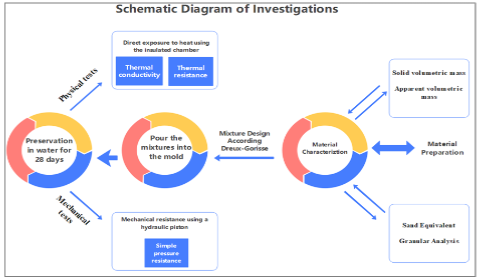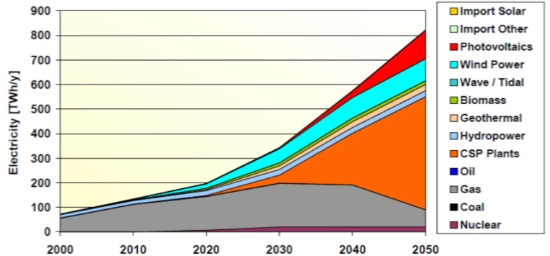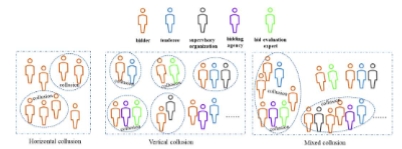Effect of natural pozzolana, pozzolanic sand, and basalt on thermal and mechanical properties of green concrete
Abstract
Green concrete, also known as sustainable concrete, is a building material that aims to reduce environmental impact by using natural, recycled, or sustainable materials in its production. One way to achieve sustainability in concrete is to replace cement with pozzolanic materials, which not only reduces the carbon footprint but also improves the performance of concrete and reduces its cost. This study aims to use natural materials that can partially or completely replace cement and conventional aggregates in concrete mixes. pozzolanic gravel (GPoz) replaced coarse aggregate, basaltic sand (SBas) and pozzolanic (SPoz) replaced fine aggregate, while ground pozzolana (PN) replaced cement. This work focuses on the experimentation and simulation of concrete mixes using the four abovementioned materials. 36 cubes were cast to conduct the thermal conductivity test by direct exposure of concrete samples, where an insulated thermal chamber was designed from thermal bricks, equipped with a heat source from the bottom and an empty space for the tested sample from the top, and then the resistance test on simple pressure was conducted for the cubic samples at the age of 28 days. Pozzolanic aggregate, when used in combination with basalt sand, showed greater thermal resistance compared to conventional concrete. Even with the replacement of 50% of the cement with ground pozzolana, we notice an increase in resistance of more than 11%, but with the replacement of basalt sand with pozzolana sand, we notice an increase in thermal resistance of more than 53%. As for the mechanical properties represented by resistance on simple pressure, we notice an acceptable decrease in resistance when replacing cement with pozzolana, with the exception of mixtures containing aggregates and pozzolana sand together, where replacing 50% of the cement with pozzolana increases the resistance on simple pressure by more than 46.4%.
References
[1]Santamouris, M. and K. Vasilakopoulou, Present and future energy consumption of buildings: Challenges and opportunities towards decarbonisation. e-Prime-Advances in Electrical Engineering, Electronics and Energy, 2021. 1: p. 100002.
[2]Омран, Д.Ю. and М.А. Вассуф, Использование информационного моделирования строительных объектов (BIM) с целью изучения ориентации здания при проектировании для достижения их большей устойчивости. Вестник МГСУ, 2024. 19(3): p. 436-455.
[3]Andrew, R.M., Global CO 2 emissions from cement production, 1928–2018. Earth System Science Data, 2019. 11(4): p. 1675-1710.
[4]Guo, R., et al., Global CO2 uptake of cement in 1930–2019, Earth Syst. Sci. Data Discuss. 2020.
[5]Sivakrishna, A., et al., Green concrete: A review of recent developments. Materials Today: Proceedings, 2020. 27: p. 54-58.
[6]Xing, W., et al., Life cycle assessment of sustainable concrete with recycled aggregate and supplementary cementitious materials. Resources, Conservation and Recycling, 2023. 193: p. 106947.
[7]Alghamdi, H., A review of cementitious alternatives within the development of environmental sustainability associated with cement replacement. Environmental Science and Pollution Research, 2022. 29(28): p. 42433-42451.
[8]Ngew, S.H., The Awareness of Green Concrete among Property Developers in Klang Valley. 2018, Tunku Abdul Rahman University College.
[9]Das, S., et al., Geopolymer concrete: Sustainable green concrete for reduced greenhouse gas emission–A review. Materials Today: Proceedings, 2022. 60: p. 62-71.
[10]Soni, A., et al., Challenges and opportunities of utilizing municipal solid waste as alternative building materials for sustainable development goals: A review. Sustainable Chemistry and Pharmacy, 2022. 27: p. 100706.
[11]Althoey, F., et al., Advancements in low-carbon concrete as a construction material for the sustainable built environment. Developments in the Built Environment, 2023: p. 100284.
[12]Mohamad, N., et al., Environmental impact of cement production and Solutions: A review. Materials Today: Proceedings, 2022. 48: p. 741-746.
[13]Abdullah, H.H., N.A. Al-Saadi, and K.A. Maala, Natural Iraqi pozzolana found in Anjana area, southern Hamrin Mountain, central Iraq. Iraqi Bulletin of Geology and Mining, 2006. 2(2).
[14]Osei, D. and E. Jackson, Compressive strength and workability of concrete using natural pozzolana as partial replacement of ordinary Portland cement. Advances in Applied Science Research, 2012. 3(6): p. 3658-3662.
[15]Ekolu, S.O., R.D. Hooton, and M.D.A. Thomas, Studies on Ugandan Volcanic ash and Tuff, in Proceedings from the International Conference on Advances in Engineering and Technology, J.A. Mwakali and G. Taban-Wani, Editors. 2006, Elsevier Science Ltd: Oxford. p. 75-83.
[16]Kheirbek, A. and N.A. , Study the Influence of Replacement the Aggregates of Mortar with Natural Pozzolana on its Fresh and Hardened Properties. Tishreen University Journal for Research and Scientific Studies - Engineering Sciences Series, 2014. 36(3).
[17]al-Swaidani, A.M., Use of micro and nano volcanic scoria in the concrete binder: Study of compressive strength, porosity and sulfate resistance. Case Studies in Construction Materials, 2019. 11: p. e00294.
[18]Al-swaidani, A.M., Natural pozzolana of micro and nano-size as cementitious additive: resistance of concrete/mortar to chloride and acid attack. Cogent Engineering, 2021. 8(1): p. 1996306.
[19]Bordeian, G.S., Characterisation and properties of alkali activated pozzolanic materials. 2000: Sheffield Hallam University (United Kingdom).
[20]Ponzi, G.G.D., et al., Basalt powder as a supplementary cementitious material in cement paste for CCS wells: chemical and mechanical resistance of cement formulations for CO2 geological storage sites. International Journal of Greenhouse Gas Control, 2021. 109: p. 103337.
[21]Abdelgader, H.S., et al., Cement kiln dust, in Sustainable Concrete Made with Ashes and Dust from Different Sources. 2022, Elsevier. p. 451-479.
[22]Kumar, A. and A. Kumar, Comparative Study on Green and Conventional Concrete. 2024.
[23]Yongsheng, J. Costs and Pricing of Green Buildings. 2024. p. 181-191.
Copyright (c) 2024 Moustafa Wassouf , Jamal Omran, Ali Kheirbek

This work is licensed under a Creative Commons Attribution 4.0 International License.












